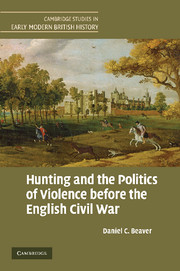Book contents
- Frontmatter
- Contents
- List of maps
- Acknowledgments
- List of abbreviations
- Introduction: Hunting, violence, and the origins of the English Revolution
- 1 Blood, sacrifice, and order: meanings of the forest and hunt in culture, politics, and society
- 2 Honor, property, and the symbolism of the hunt in Stowe, 1590–1642
- 3 Ancient liberties and the politics of the commonweal in Waltham Forest, 1608–1642
- 4 Royal honor, great parks, and the commonweal in Windsor Forest, 1603–1642
- 5 Venison and the politics of honor in Corse Lawn Chase, 1620–1642
- Conclusion: Royal symbols, forest politics, and popular politics in early modern England
- Bibliography
- Index
- Titles in the series
5 - Venison and the politics of honor in Corse Lawn Chase, 1620–1642
Published online by Cambridge University Press: 06 March 2010
- Frontmatter
- Contents
- List of maps
- Acknowledgments
- List of abbreviations
- Introduction: Hunting, violence, and the origins of the English Revolution
- 1 Blood, sacrifice, and order: meanings of the forest and hunt in culture, politics, and society
- 2 Honor, property, and the symbolism of the hunt in Stowe, 1590–1642
- 3 Ancient liberties and the politics of the commonweal in Waltham Forest, 1608–1642
- 4 Royal honor, great parks, and the commonweal in Windsor Forest, 1603–1642
- 5 Venison and the politics of honor in Corse Lawn Chase, 1620–1642
- Conclusion: Royal symbols, forest politics, and popular politics in early modern England
- Bibliography
- Index
- Titles in the series
Summary
I need not complain of the times; every traveler tells them; they are as clear to see as an Angel in the sun.
Henry Osborne, October 1642In early October 1642, a tract of forest and deer chase in the Severn valley northwest of Gloucester, known as Corse Lawn, became the site of a grisly spectacle. Many of the words and techniques used in this grim performance reprised the incidents in Stowe, Waltham, and Windsor earlier in the year. Richard Dowdeswell, steward of Corse Lawn Chase, described the scene in a letter to Lionel Cranfield, Earl of Middlesex, the absentee owner resident in Great St. Bartholomew in London. Dowdeswell delivered terrifying news of how “a rising of neighbors about Corse Lawn” destroyed more than 600 of Middlesex's deer in a “rebellious, riotous, devilish way,” a hideous consequence of what Dowdeswell termed “this time of liberty.” Dowdeswell rode to the site from his estate at Pull Court, a few miles from the chase, and “appeased the multitude, yet some scattering companies gave out in alehouses that they would not only destroy the remainder of deer but rifle your lordship's house at Forthampton and pull it down to the ground and not let a tree or bush stand in all the chase.” The deer massacre became an assault on the chase, the forest, and the manor house of Forthampton, an estate close to the chase but not included in the meets and bounds of the forest.
- Type
- Chapter
- Information
- Publisher: Cambridge University PressPrint publication year: 2008



